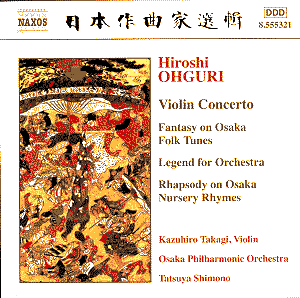There
are occasions when a composer’s birthplace, date of birth and
entire biography are the most important key in the understanding
of the music. With Hiroshi Ohguri this is certainly one of those
occasions. Osaka, his home town, is even now well isolated from
the main centre, Tokyo. It has its own culture and its own language
or certainly dialect (Osaka-ben). It also has its own tunes. These
are woven by Ohguri into all of his music including the pieces
on this disc - another in Naxos’s ongoing series of ‘Japanese
Classics’.
During
his childhood in the town of Osaka traditional instruments and
tunes were a daily part of his fairly middle-class life. He studied
the French horn and played in the Tokyo Symphony Orchestra. There
he learned the basic Western repertoire at firsthand. Later he
joined the same Osaka Philharmonic who play here.
In
his detailed booklet notes, printed microscopically by Naxos,
Morihide Katayama writes "The strong relationship between
his music and provincialism has given rise to a legend that only
players and ensembles from Osaka can interpret Ohguri’s music
correctly". Well at present we shall never know as the Osaka
Philharmonic play so brilliantly here. There are no comparative
versions in the catalogue so we must take that statement on trust
for now. The music is not utterly Japanese but has a strong Western
influence. The orchestration is especially deft and obviously
learned from the giants of the 20th Century. Indeed
the start of the Violin Concerto reminded me, both in melodic
material and orchestration, of Bartók’s 2nd
Violin Concerto. The dynamic rhythmic energy of the third movement,
although based like much of his music on Japanese songs and dances,
only served to remind me of Khachaturian and even of Kodály’s
‘Dances from Galanta’.
Although
the Violin Concerto is a fine work and Kazuhiro Takagi is undoubtedly
a young and dazzling virtuoso, it wasn’t this work but the other
three that captivated my imagination.
The
‘Fantasy on Osaka Folk Tunes’ begins almost like Gagaku with piccolo,
percussion and wailing strings. The variants on the bass which
follow are an exciting synthesis of Japanese sounds and the Western
Orchestra. Pentatonic melodies and strong rhythms mark out many
passages of the piece but the quiet section in the middle is like
a cool breath of a Japanese water garden. The antecedents of the
melodies are given in detail and the whole work is well worth
investigating.
If
the title ‘Legend’ reminds you of John Ireland or Arnold Bax,
then in a sense you are not too far away. It is a fascinating
work which repays careful listening. It is dramatic and late-
Romantic in style with much use of percussion. Here we have a
complex Japanese folk-tale carefully constructed into a fifteen
minute tone poem. It also mixes local folk melodies with Western
harmony and is colourfully orchestrated.
Finally
the ‘Rhapsody’ is, I feel, a slightly weaker work. It is a little
too diffuse in form and seems to have to resort to bombast, as
with the Waltonian opening fanfares. It covers the same ideas
and language as the other two pieces but it does serve to bring
the disc to a rousing conclusion.
To
sum up: these are excellent performances, vividly recorded. This
is music which through a distinctive voice and some originality
links past and present. I have gained much enjoyment from this
disc and I must say that we played it for pleasure more times
than writing a review necessitates. I can’t say that for quite
a number of CDs which come my way.
Gary
Higginson
